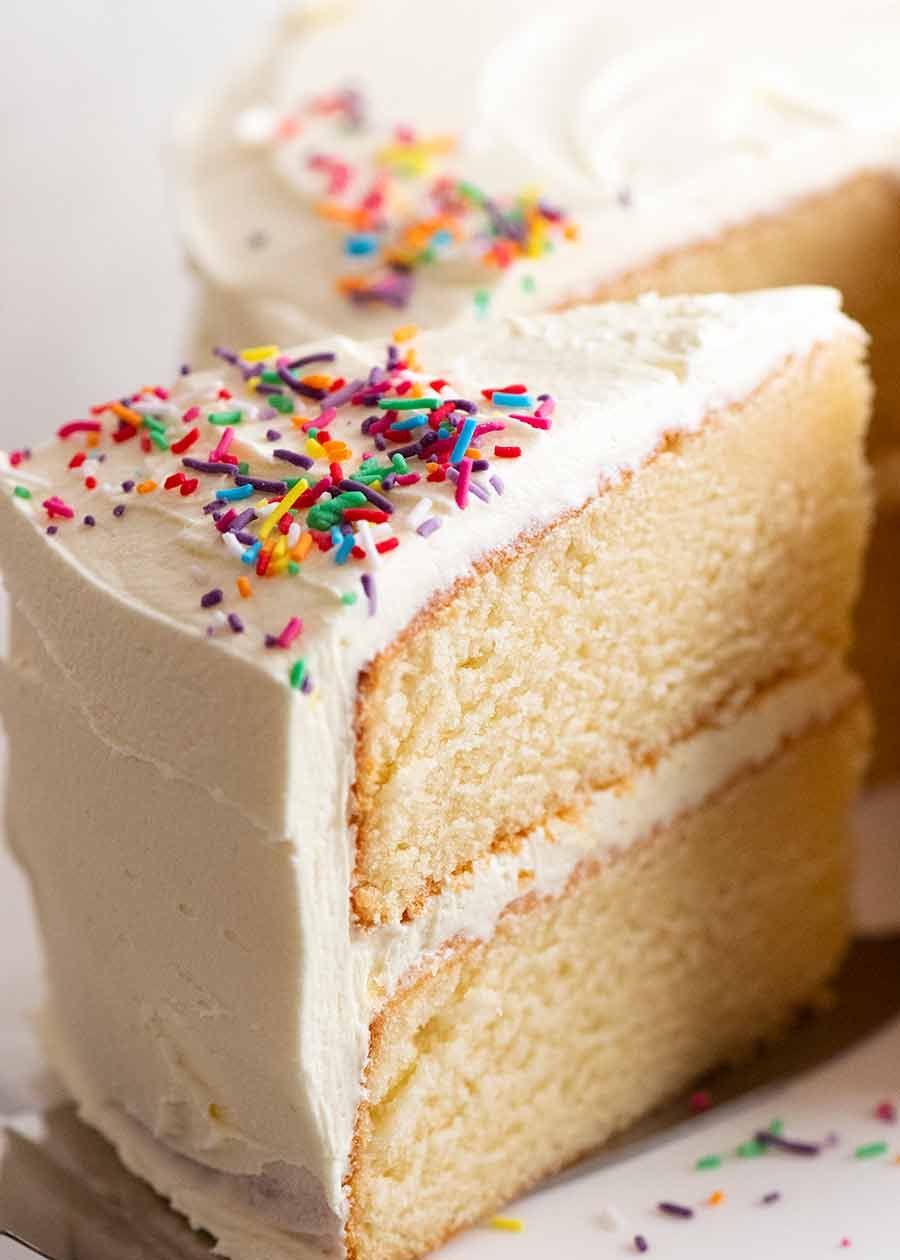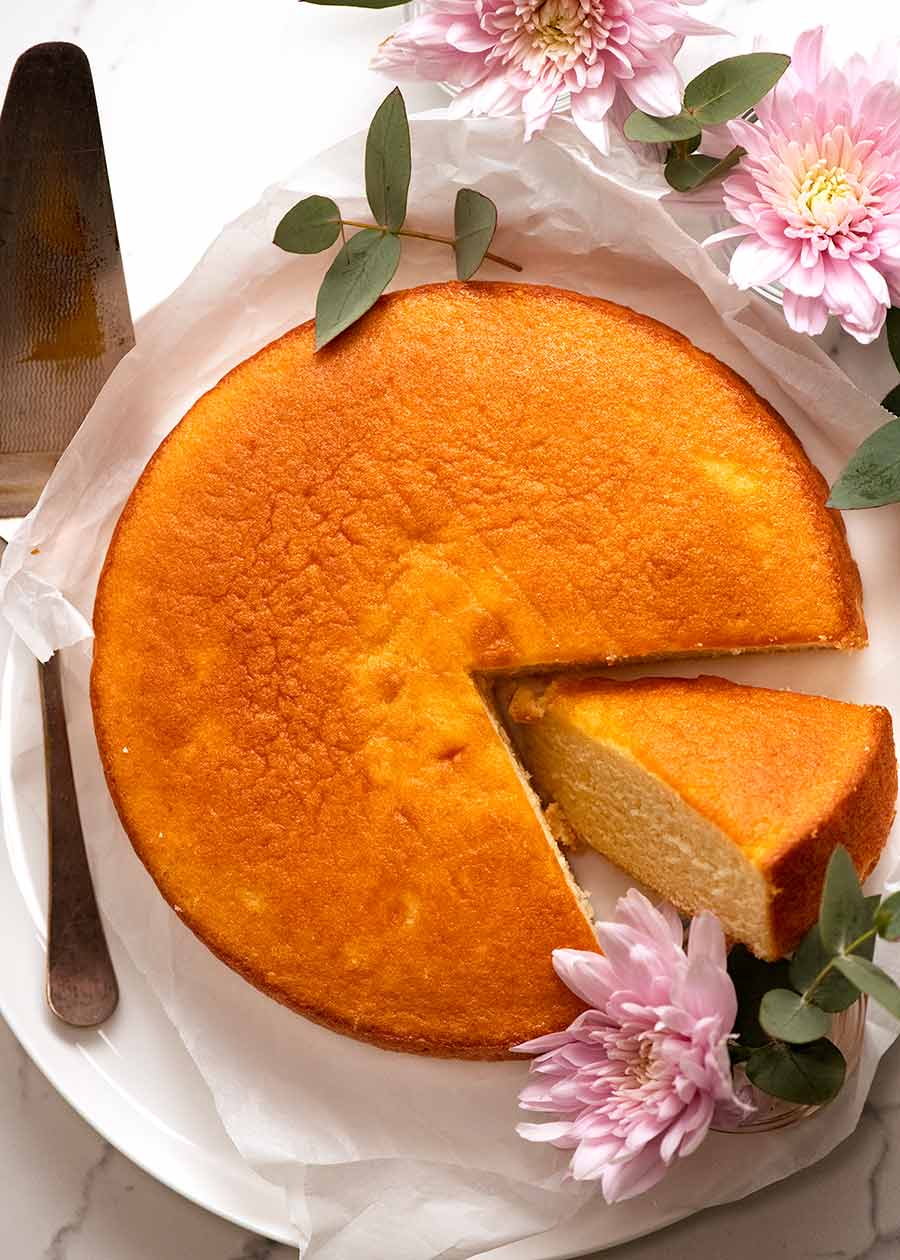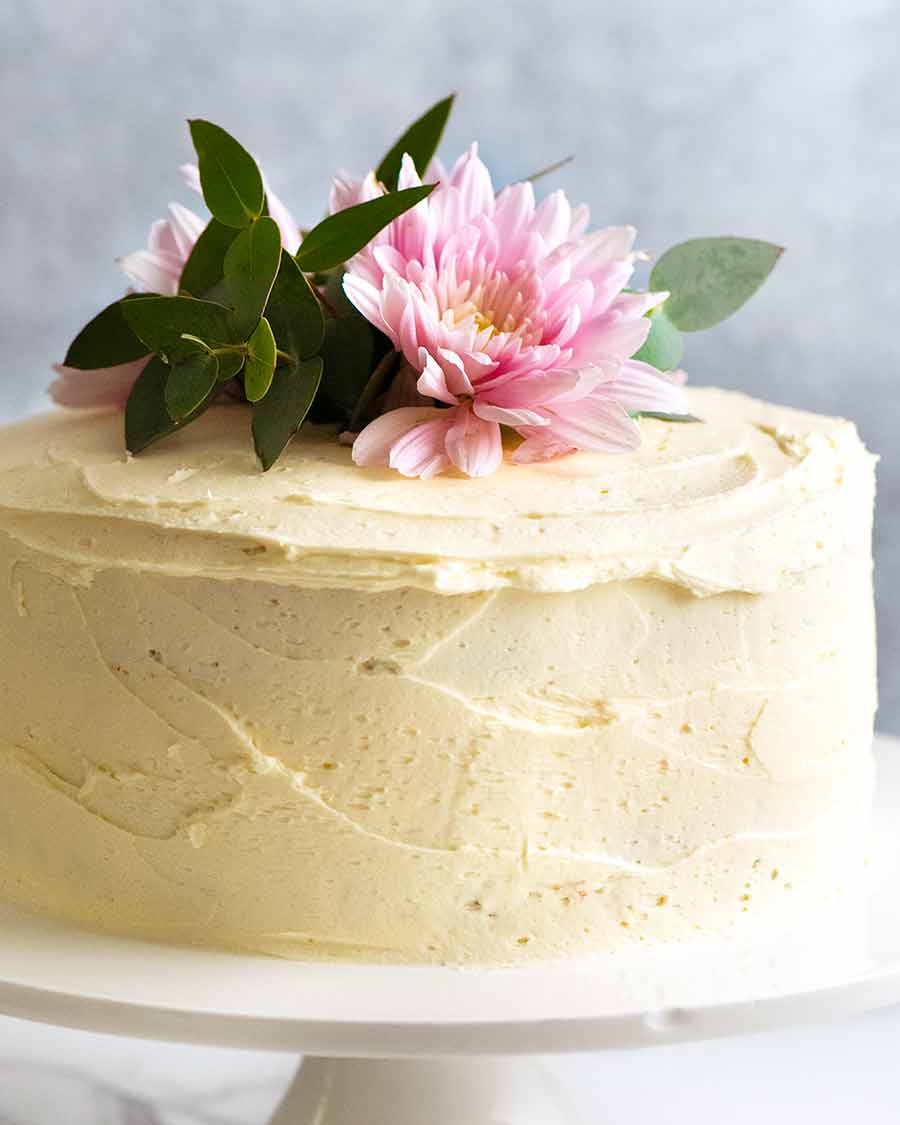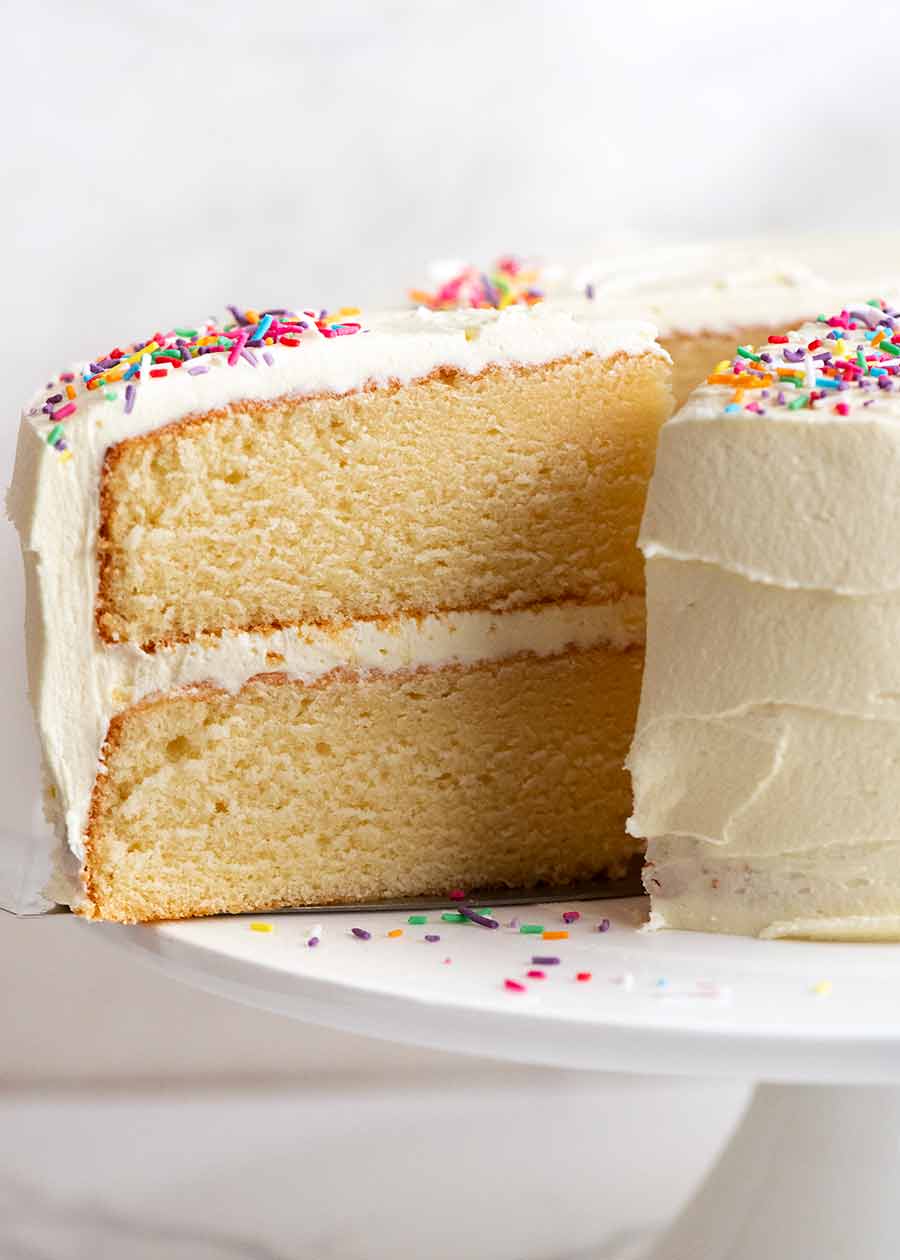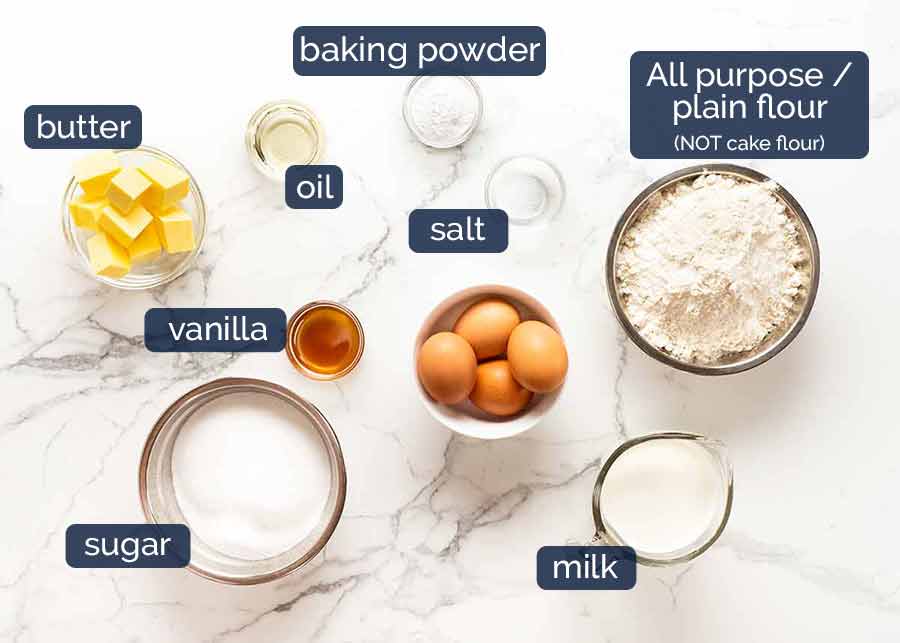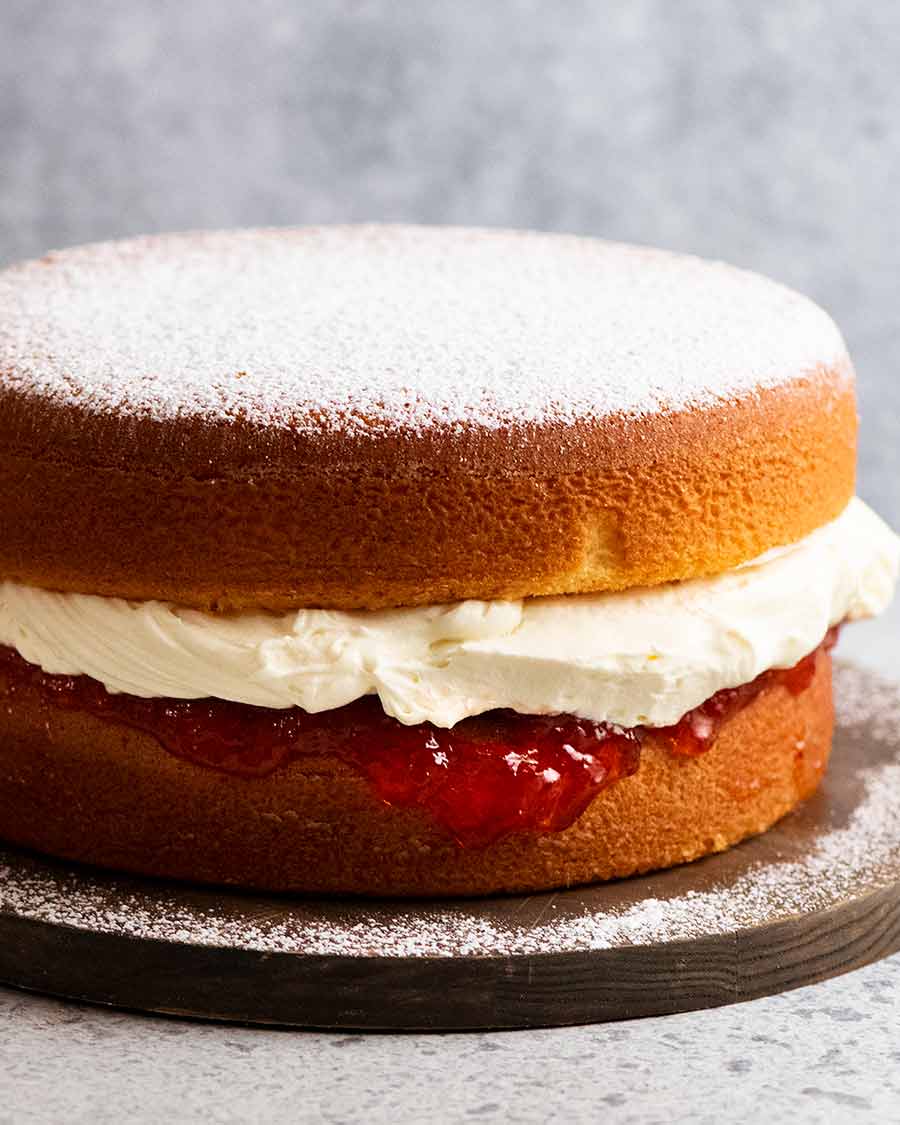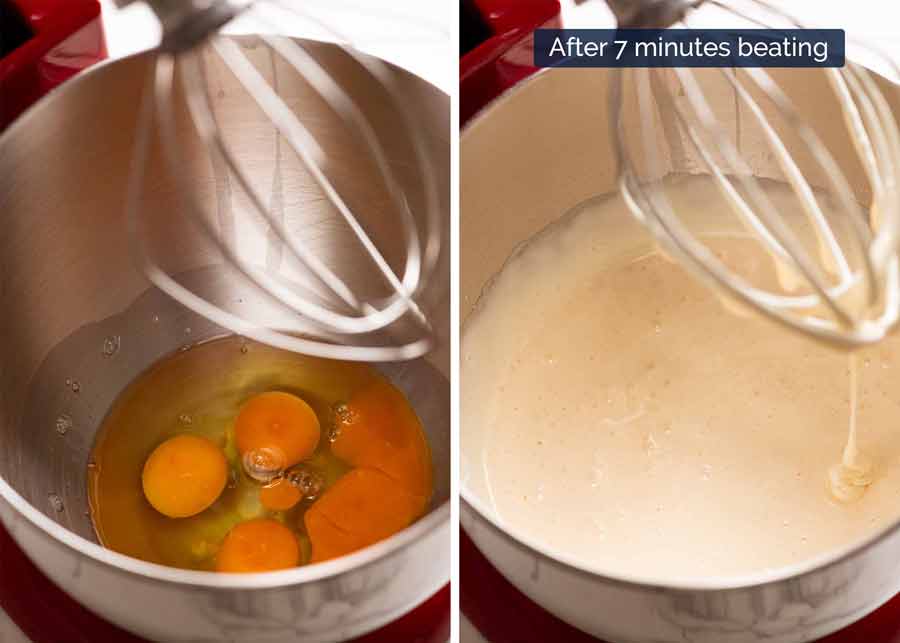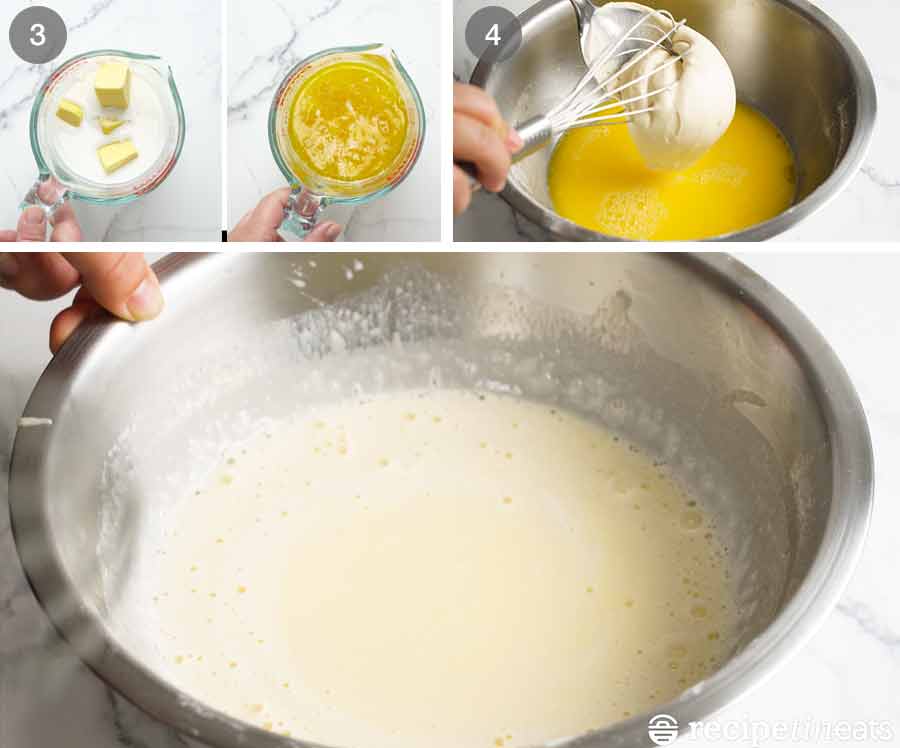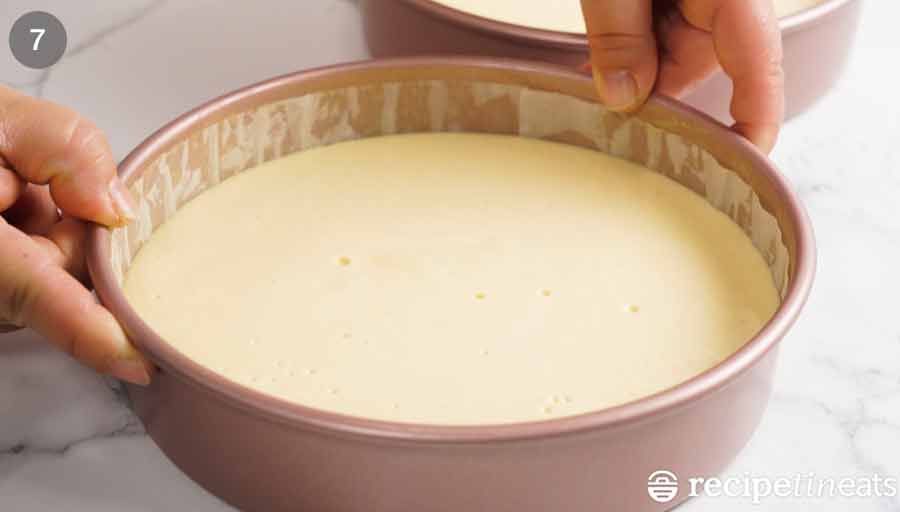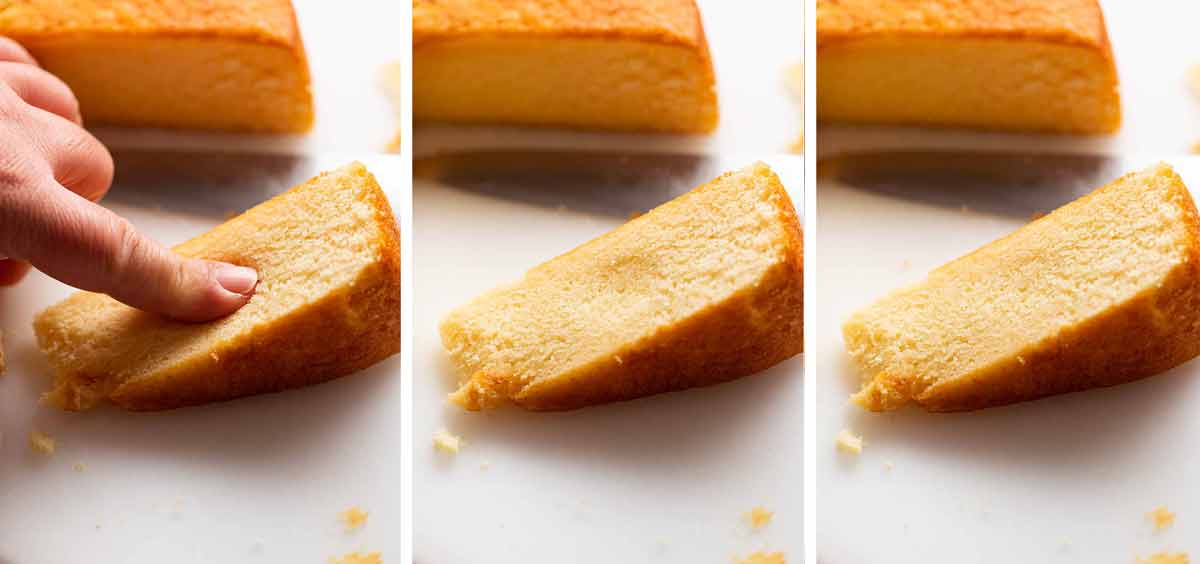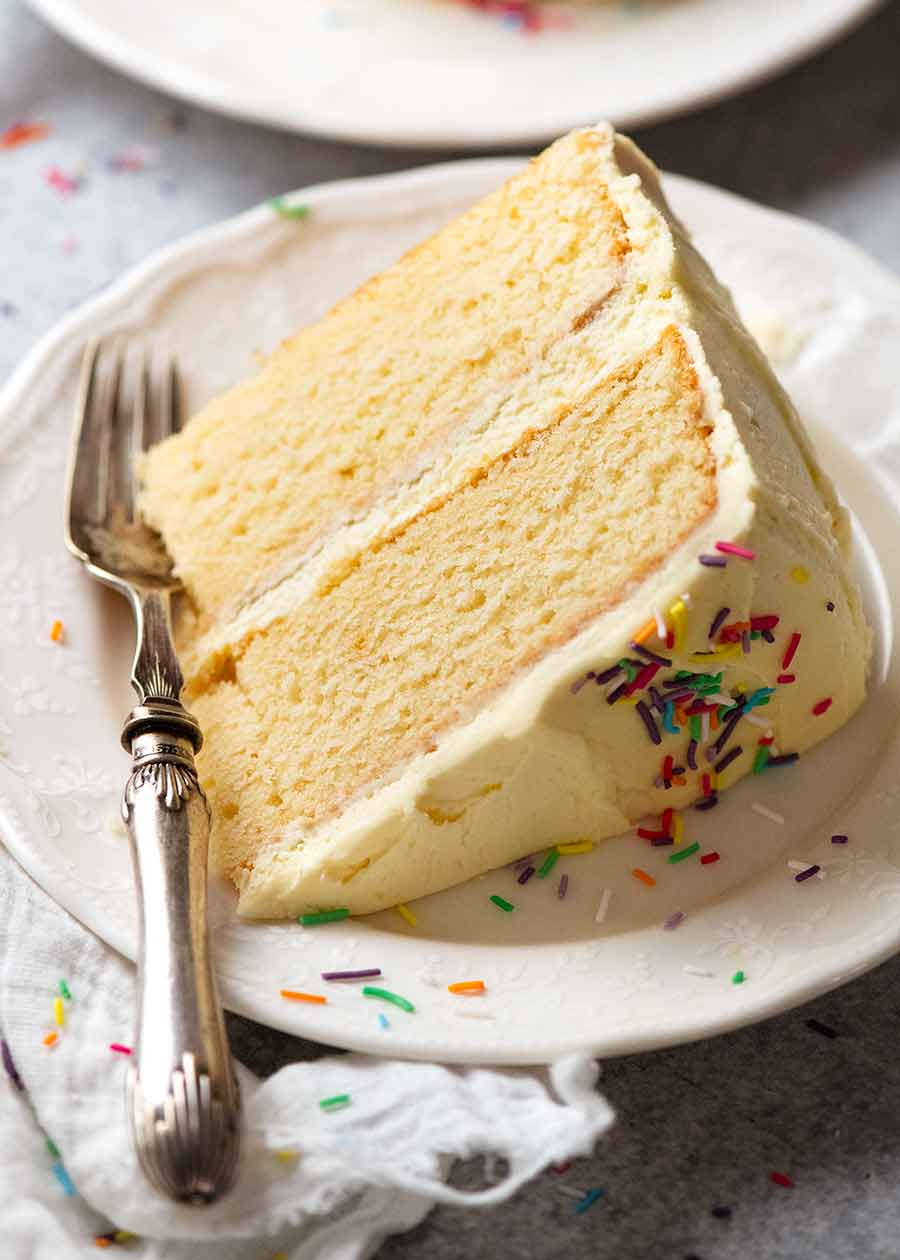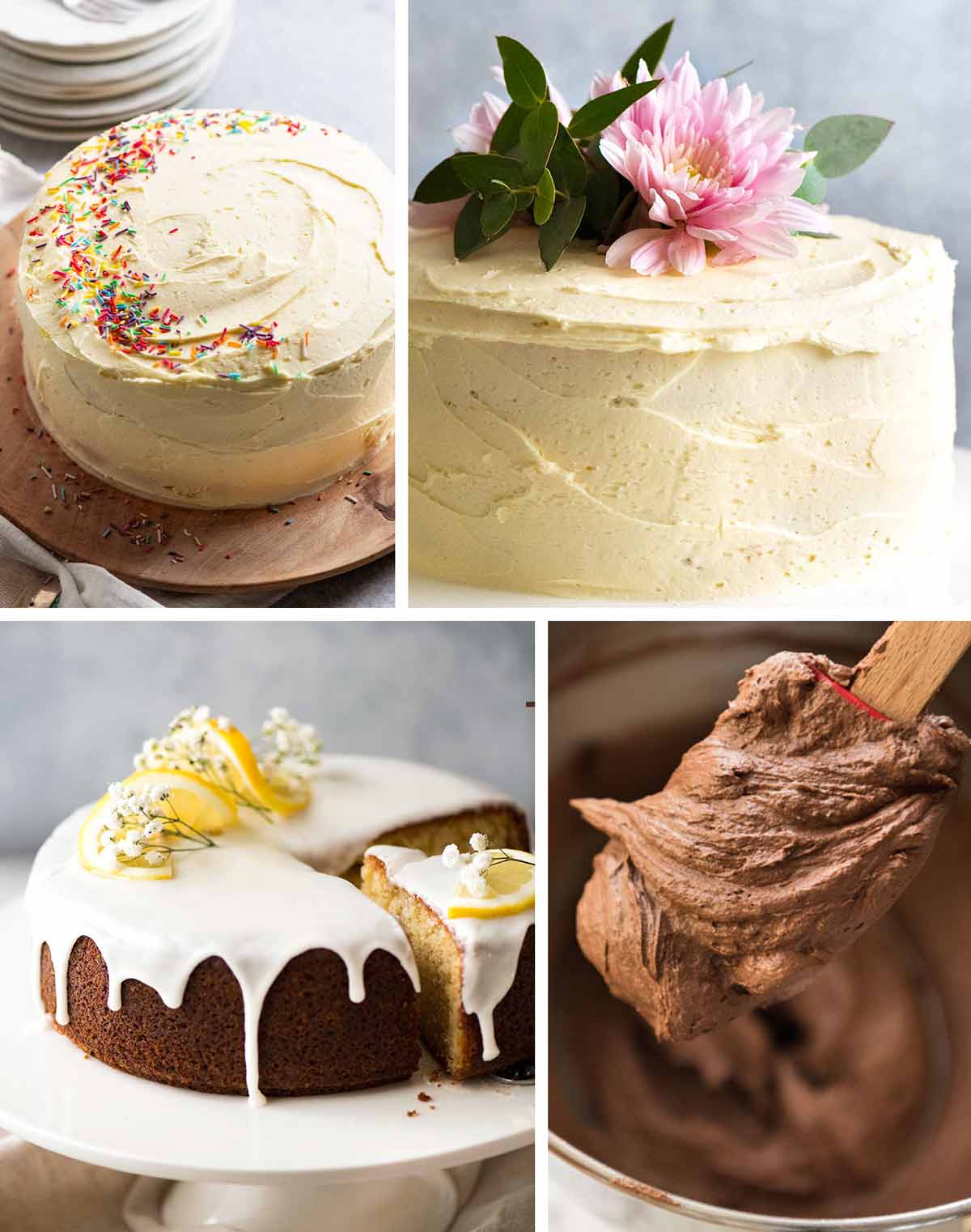This is a reader favourite recipe included by popular demand in my debut cookbook “Dinner”.
My best Vanilla Cake recipe is…..
Plush, moist, fluffy crumb without being freakishly unnaturally so (as some store bought can be). No more dense cakes! Keeps near perfectly for 4 whole days. 100% fresh on Day 1, still 96% perfect on Day 4. That’s unheard of! Lovely vanilla and butter flavour without a greasy mouthfeel; Even, elegant crumb – no large tunnels or irregular, crumbly holes; Bakes perfectly flat – no levelling required! Makes perfect cupcakes; Not overly sweet; and As tender as it can be but still be stable enough to make a large layered cake smothered with frosting or piles of cream and berries. In contrast, Chiffon Cakes and Japanese Sponges which, while lighter still, cannot actually hold up to much extra weight – the bottom layer gets quite squished.
So if all that appeals to you too, then I dare say this might become YOUR favourite vanilla cake recipe too! And here’s a little preview to show you how soft and fluffy it still is after 4 days:
Freshness preview – this cake is 4 days old!
The words “best served on the day” on a cake recipe is never a good sign – it means it drastically degrades overnight. But THIS cake recipe is near perfect for 4 days – even 5 days! But it’s more sturdy than Japanese cakes which are so delicate, they can really only be decorated with cream. Anything heavier and the bottom layer gets squished! Also, importantly, this cake incorporates my cake shelf-life requirement to stay perfectly fresh for at least 2 days after it’s made. (This lasts perfectly for 4 days.) Because who bakes cakes on the day they are intended to be served?? Interestingly, baking experts will recognise the method and ingredients in this cake to be very similar to what is called a Hot Milk Cake in America – albeit strangely it’s often described as a “dense” cake, presumably because they don’t preserve the egg aeration to the extent I insist we do and also because sometimes it’s baked in bundt pans which takes far longer to bake (= dense cake). I don’t want to get too cake nerdy with you… but one sign of a well made cake is an even crumb. No large tunnels or lots of irregular size holes. It looks and tastes velvety – a similar plush texture to Red Velvet Cake. There’s a widely held misconception that cake flour is the secret to a better cake. That’s only true for certain cakes. For this one, plain / all purpose flour yields better results.
Ingredients in my Best Vanilla Cake recipe
Here’s what you need to make this plush, soft vanilla cake. No cake flour, no buttermilk, no sour cream. Tried them all – this cake is better with plain / all purpose flour and just milk.
Plain / all purpose flour – compared to cake flour, the flavour of the butter and vanilla comes through better, the crumb is slightly more velvety AND it keeps slightly more moist too. Bonus: no need to hunt down / pay a premium for cake flour! Do not substitute with self raising flour or gluten free flour. Eggs – whipped to aerate, these are key to make the cake extraordinarily light and fluffy. You don’t get an eggy flavour; Baking powder – not baking soda (bi-carb), it doesn’t rise as well. This is our safety net, extra helping hand to make the cake rise. Milk, full fat – just plain cow milk. Low fat works as well but rises marginally less. Do not substitute with non dairy milk or buttermilk; Sugar – best to use caster / superfine sugar if you can because it dissolves better in the eggs. But regular / granulated sugar works just fine too – you may just end up with some little brown spots on the base; Oil – just 1 tablespoon adds a noticeable hint of extra moistness, especially on Day 4, without weighing down the cake in the slightest. Don’t be tempted to add more – I tried an extra tablespoon and it didn’t rise as well; Vanilla extract – the best you can afford. Imitation will work just fine, but the flavour isn’t as pure or real. I use Queen Vanilla Extract. Don’t waste your money on vanilla beans or vanilla bean paste – it’s not worth it for cakes.
Heads up – this is a long step by step explanation post, to ensure those who are new to baking are armed with everything they need to make this cake perfectly, first time and every time! If the butter is too soft, the cake will be greasy and dense – sound familiar? If it’s too hard, you’ll never manage to cream it and you’ll end up with grease pockets. If you beat butter too long, you break the air pockets. There’s more room for error with cookies and some other types of baked goods. But the butter temperature needs to be near perfect for cakes and cupcakes. (17°C/63°F is the perfect temperature for “softened butter”). And even if you nail it, the cake rapidly loses freshness. Even the next day it’s noticeably drier. I’ve tried dozens and dozens over the years, to compare to this Vanilla Cake. This recipe puts all to shame in terms of fresh shelf life. Why is vanilla cake “so hard”? It seems hard to find the perfect cake because there is nothing to hide behind, it is one of the purest forms of baking. And the “cream butter and sugar” step is the biggest cause of problems, setting up the cake for success or failure from the very start (read above). This Vanilla Cake recipe is much more foolproof!
How to make my best Vanilla Cake
A stand mixer makes this vanilla cake a breeze to make, though it can be made with a handheld electric beater. While it takes time to beat the eggs to make a lovely fluffy cake, this recipe is more fail-proof than the usual “cream butter and sugar until fluffy” recipes – read the above box for why. The unique plush, fluffy crumb of this cake is from double lifting power – whipped eggs PLUS baking powder!
- Whip the eggs and sugar – Beat the eggs with sugar for a whole 7 minutes until thick and glossy, it changes from yellow to white, and tripled in volume (just over double depth in the bowl). The aeration created during this step is key for a soft, fluffy crumb. This is a technique borrowed from Japanese sponge cakes. TOP TIP: After this step, keep beating to a minimum otherwise you’ll knock the air out. Just follow my time and beater speeds and you can’t go wrong! Here’s what it looks like before and after beating:
- Gradually add flour – Whisk together the flour, baking powder and salt. Then add into egg mixture in 3 lots, mixing for just 5 seconds on Speed 1 in between. This should make the flour just incorporated – don’t worry if there are some bits not mixed in.
- Hot melted butter in milk – use a microwave or stove to heat milk with the butter until it melts. Believe it or not, HOT milk helps with aeration in this cake. I doubted it, so I tried with cooled melted butter in milk and found it did not rise as well. The use of hot milk with melted butter in a cake batter is another technique used in some types of Japanese sponge cakes (such as this one from Chopstick Chronicles, a Japanese food blog). Interestingly, I recently discovered it is also used in a traditional Southern cake called Hot Milk Cakes.
- Mix some batter into hot milk – this serves two purposes: a) bring down the temperature of the hot milk so it won’t “cook” the eggs (ie. tempering); and b) it lightens up the density of the hot milk (see above – it becomes foamy) so it blends together faster when added to the rest of the whipped egg mixture. Remember, minimal beating is key so we don’t knock out the cake-rising-bubbles we created in Step 1. The melted butter in hot milk infuses this cake with beautiful subtle buttery flavour without the greasy mouthfeel inherent with butter cakes.
- Slowly pour milk mixture back into whipped eggs over 20 seconds on Speed 1. Scrape down sides of bowls, then mix for 10 seconds on Speed 1 – the batter should now be smooth;
- Pour into 2 cake pans lined with parchment/baking paper. This cake can be made in various pan sizes, bundt pans and also makes perfect cupcakes. Click here for a handy table of different sizes, bake times and cake height (including 3 layer cakes).
- {Optional} Knock out big air bubbles by dropping the cake pans on the counter 3 times. This won’t affect the cake-rising bubbles created in Step 1. But it makes large bubbles in the batter rise to the surface and burst. If you don’t do this, you end up with maybe 6 or so large bubbles on the cake surface that go brown, and more unsightly large air pockets in the crumb. The surface blemishes don’t really matter if you are frosting. But if you’re not frosting the cake (eg just dusting with icing sugar / powdered sugar), you may care.
- Bake 30 minutes until golden brown and a toothpick inserted into the middle comes out clean. The cake will have a slight dome but it flattens when it cools. You may get the faintest cracks on the surface, like you can see in the middle of the left cake in the photo above. That can occur if your oven doesn’t distribute heat evenly (my left front is hotter). But don’t fret – once the cake cools and the slight dome flattens, the cracks will disappear.
- COOL upside down for level cakes (so you have neat, straight layers in a layer cake) on a cooling rack. If you don’t mind a slight dome surface / specifically want to show the beautiful golden brown surface (eg if making a cake dusted with icing sugar / powdered sugar, or a glaze), then cool it right side up; and
- Decorate! Frost with your favourite frosting, smother with cream, fresh berries, swirl with chocolate fudge frosting or simply dust with icing sugar and serve with a dollop of yogurt or cream!
Day 4 – still super moist and fresh
The photos below are my attempt to show you how incredibly soft the cake still is four days after it’s made! If it were dry like typical butter cakes that start with “cream butter and sugar until fluffy”, the crumb would break when I jabbed it, and it would never spring back.
Tips for Vanilla Cake success
You’ll love that this list is a lot less stern than many other cake recipes!
Eggs at room temperature – these will fluff better and faster. It’s easy to warm up fridge cold eggs – just leave in warm water for 5 minutes. What’s a room temperature egg? Pick up the egg. Fridge cold? Too cold. Cool but not cold? That’s ok. Very warm? I would be worried they might be off! (Note: fridge cold eggs will still fluff just fine, but it takes a couple of minutes longer. Just more consistent results with room temp eggs). De-chill icy cold mixing bowls – Cold kitchen? Cold bowls! Run them under warm tap water then dry before using. Not hot tap water – just warm. Why? Eggs aerate faster and better when slightly warm. Cold bowl will lower temperature of eggs. This is a general useful baking tip – eg softened butter creamed in an icy cold bowl will make it firm up. Make sure your baking powder is still good – if you do everything right and the batter looks like it does in my video, but your cupcakes don’t rise, the culprit is probably your baking powder. Even if it’s not past the expiry date, if not stored in a cool dry place, or if “someone” left the lid off for days, it can lose rising power. See here for how to check if your baking powder is still good. Make sure the milk and butter are hot when you mix in the batter. I don’t understand the science, all I know is that when I melted the butter in the milk ahead of starting the batter, then let it cool to lukewarm while I faffed around getting everything else ready, the cake didn’t rise as well. Once you start, don’t stop – once you start beating the eggs, keep going until the cake is in the oven. Do not at any point stop and take a call from your chatty Aunt Margorie! Reason: bubbles in batter will subside if left sitting around, resulting in a dense cake. Follow steps in the order per recipe – I’ve written out the steps very specifically in the most efficient order for the best result. Don’t try to do things ahead like melting the butter in hot milk then leave it sitting around while you do everything else – it will either cool (cake doesn’t rise as well) or it gets a skin on it (this doesn’t dissolve in batter). Cake pan WITHOUT loose base is best – the batter is quite thin so it can leak a bit if using springform pan or loose base sandwich pans. Not much, but a bit. Not the end of the world – you can prevent this by greasing the base extra well and “plugging” the gap with butter. Recipe can be halved for one single layer cake, baked in one pan. However if you do make a full batch, do not try to bake all batter in one pan or it won’t rise as well. Only exception is bundt pan – the hole in the middle helps with faster heat distribution.
Ideas for frosting and decorating Vanilla Cake
Here are a few ideas for finishing this Vanilla Cake.
2 x 20cm / 8″ cake pan – my base recipe (I like the cake height, slightly tall), 30 minutes 3 x 20cm / 8″ cake pan – 21 minutes (if all one one shelf). Otherwise, put 2 on middle shelf and 1 pan on shelf underneath. Bake top 2 pans for 21 minutes, remove from oven. Move bottom pan up and bake for another 2 minutes then remove. 2 x 23 cm / 9″ cake pans – 27 minutes 2 x 15.25cm / 6″ cake pans – 25 – 27 minutes, only make half a batch Halve the recipe for a single round cake, 20 – 23cm / 8 – 9″ 12 cup tube pan or bundt pan (grease & dust with flour) – bake 1 hour, but note cake is not quite as fluffy as pictured and described. Still soft, but it’s slightly more dense (still delicious and thoroughly enjoyable, just different to intended) 23 x 33 cm / 13 x 9″ rectangle pan – 30 minutes (large single layer sheet cake, excellent for large groups) CUPCAKES! 24 perfectly domed, golden cupcakes – or halve the recipe to make 12. Here’s the Vanilla Cupcakes recipe.
And with all that – I’m finally done. Finally happy. This is THE Vanilla Cake recipe that is my best all rounder. For birthday cakes, special occasions, to make to impress the pants off your family and friends. And now it’s all over to you — tell me what you think! – Nagi x
Watch how to make it
This recipe features in my debut cookbook Dinner. Mostly new recipes, but this recipe is a reader favourite included by popular demand!
Life of Dozer
Dozer on the job (and doing it a little too well, as you will see. 😂)
